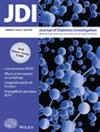The prevalence of hepatitis B infection and anti-HCV antibody in patients with diabetes mellitus
Abstract
Background
The liver's role in glucose metabolism and hormone regulation links liver infections to diabetes mellitus. Understanding this interaction is crucial for managing diabetes in affected patients.
Objective
Golestan Province has the highest incidence of hepatitis B virus (HBV) infection in the country. The current research aimed to assess the prevalence of HBV infection and anti-HCV antibodies among diabetic patients in the region, providing insights to improve disease management and prevention.
Methods
Data from 31,803 diabetic patients, collected (2019–2023) from the NAB system at Golestan University of Medical Sciences, were used to evaluate the co-occurrence of HBV infection and anti-HCV antibodies in them. Also, this study analyzed the co-occurrence of diabetes in three/two-generation CHB (Chronic Hepatitis B) patients, and recovered patients, demographic factors, liver enzyme, and viral DNA levels. Binary logistic regression was applied to identify factors associated with diabetes.
Results
HBsAg and anti-HCV antibody positivity were found in 2.52% and 0.53% of diabetic individuals, respectively. Diabetic patients with HBV infection (P-value = 0.003) or anti-HCV positivity (P-value = 0.008) had significantly lower BMIs. HBV prevalence was higher among married individuals (78.4%, P-value = 0.01) and rural residents (61.7%, P-value = 0.3). Diabetic patients with two or three generations of HBV/diabetes had higher liver enzyme levels and HBV viral loads compared to those without diabetes (P-value < 0.05).
Conclusions
In individuals with diabetes, compared to those without the disease, there was a correlation between HBV infections and altered liver function indicators, as well as HBV viral load. Additionally, familial susceptibility to HBV infection or anti-HCV antibody positivity was significant.


 求助内容:
求助内容: 应助结果提醒方式:
应助结果提醒方式:


